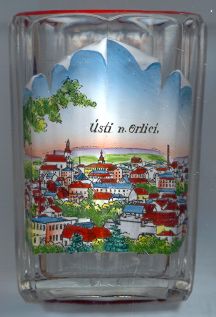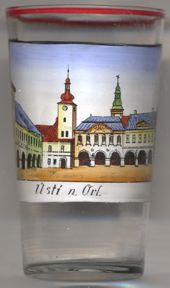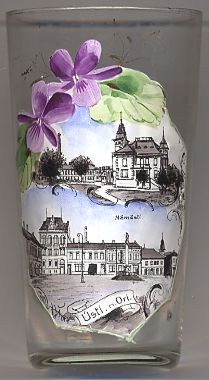

|
| ČESKÁ REPUBLIKA | CZECH REPUBLIC |
| Pardubický kraj | Pardubice region |
| Okres: Ústí nad Orlicí |
 Ústí nad Orlicí (Wildenschwert) is situated at an elevation of 348 m at the river
Tichá Orlice (Stille Adler) in the Pardubice region of eastern Bohemia. Ústí nad Orlicí is the
centre of the district of the same name. The municipality has a population of about 15,000 (2009).
Ústí nad Orlicí (Wildenschwert) is situated at an elevation of 348 m at the river
Tichá Orlice (Stille Adler) in the Pardubice region of eastern Bohemia. Ústí nad Orlicí is the
centre of the district of the same name. The municipality has a population of about 15,000 (2009).
Wilhelmswert (later in German: Wildenschwert) was founded 1241. It was first part of the domains of Lanškroun (Landskron). In 1292 the Bohemian King Wenceslav II gifted the town to the Cistercian monastery of Zbraslav (Königsaal). In 1358 the town passed to the bishopric of Litomyšl (Leitomischl). After the Hussite Rebellion in the early 14th century, the ownership of the town changed several times before it came into possession of the princes of Liechtenstein in 1622. Wildenschwert was first referred to as a town in 1544. The town was slow to recover from the lootings of the Thirty Years' War (1618–1648), then was destroyed by fire in 1706. It gained municipal status in 1795. When Wildenschwert was connected to the railway network by the railroad line from Olomouc (Olmütz) to Prague in 1845, the textile business boomed. The expanding textile factories earned the town the nickname 'The Manchester of Eastern Bohemia'. It was an important railway junction and from 1850 became a regional centre. Wildenschwert was a predominantly German-speaking town in the Austro-Hungarian monarchy until it became part of Czechoslovakia in 1918 at the conclusion of World War I. Ústí nad Orlicí as it was now called remained an important textile town, and in the 1960s the Výzkumný ústav bavlnářský (Cotton Researching Institute) developed the open-end spinning technique that provided a faster alternative to ring spinning. The historical town centre was listed among the Czech national urban treasures in 1991.

Glass no. 4515 [near left] shows a view of
 Mirové náměstí
Mirové náměstí
The  church of the Assumption of the Virgin Mary [background left]
was built in 1770–1776 as the main Roman Catholic church of the town in place of an older church that was
built in the 13th century.
church of the Assumption of the Virgin Mary [background left]
was built in 1770–1776 as the main Roman Catholic church of the town in place of an older church that was
built in the 13th century.
The Baroque  town hall [centre] with its prismatic tower was built in 1721–1723.
town hall [centre] with its prismatic tower was built in 1721–1723.

The  Municipal Museum (Městské muzeum) [near left, no. 2605: top
picture] was built in 1907 in Art Nouveau style. It was reopened in 1995 after having been closed for 35 years.
In 2008 the building was renovated.
Municipal Museum (Městské muzeum) [near left, no. 2605: top
picture] was built in 1907 in Art Nouveau style. It was reopened in 1995 after having been closed for 35 years.
In 2008 the building was renovated.
The bottom picture on glass no. 2605 [near left] shows a view of
Mirové náměstí (Peace Square) in the centre of the town with the Baroque
 Marian
Marian
[http://en.wikipedia.org/wiki/Ústí_nad_Orlicí;
http://www.czecot.com/tourist-attraction/7109_municipal-museum-usti-nad-orlici, http://www.turistik.eu/cz/kraje/pardubitzer-kreis/okres-usti-nad-orlici/usti-nad-orlici/mestske-muzeum-usti-nad-orlici/;
http://www.ustinadorlici.cz/data/index.php?sc=fotogalerie&pg=index;
https://cs.wikipedia.org/wiki/Kostel_Nanebevzet%C3%AD_Panny_Marie_(%C3%9Ast%C3%AD_nad_Orlic%C3%AD)]
![[scale]](lineal.jpg)